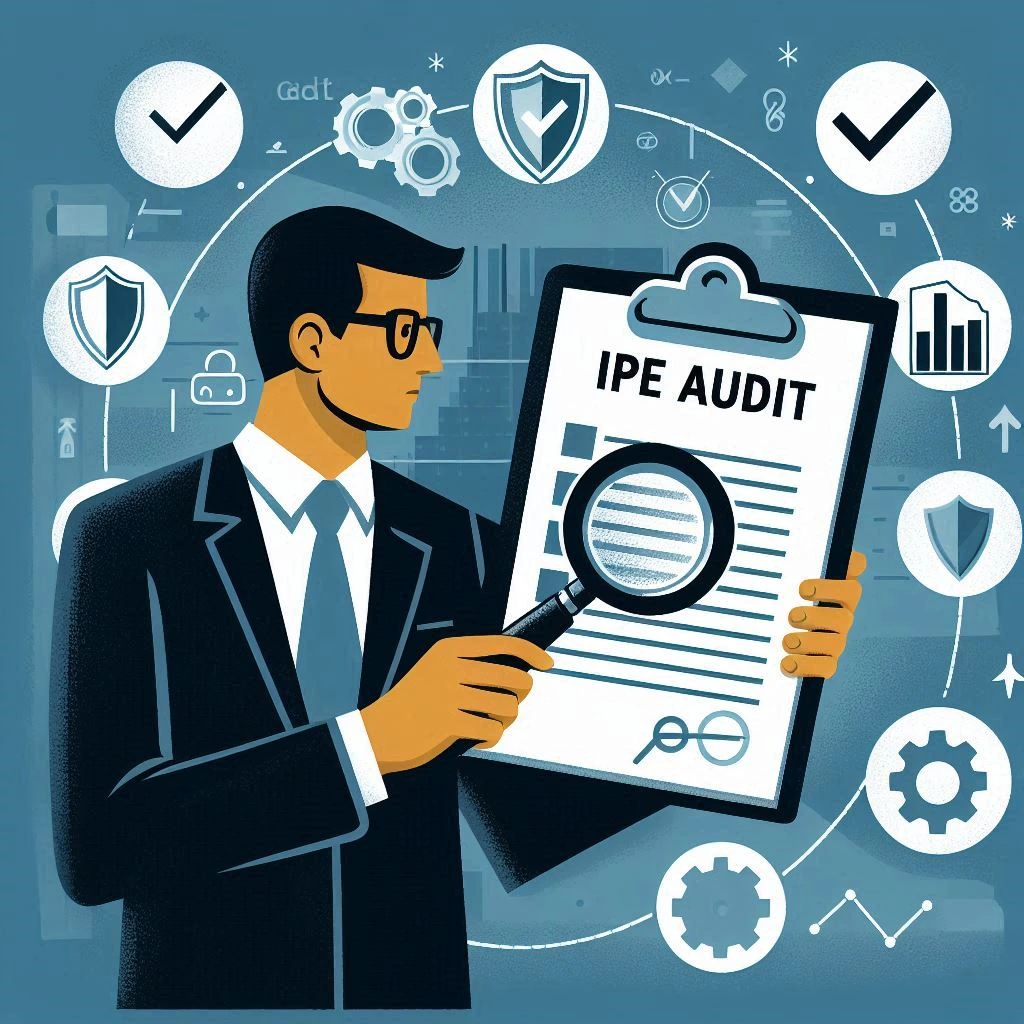Introduction to IPE Audits
The concept of Information Produced by the Entity (IPE) audits plays a crucial role in ensuring the integrity and reliability of data used in decision-making processes. IPE audits focus on evaluating the information generated by an organization, which is essential for effective risk management and compliance with regulatory standards. This section aims to provide a foundational understanding of IPE audits, their significance in the internal audit process, and their alignment with broader risk management frameworks.
Defining IPE Audits
IPE audits are designed to assess the quality and reliability of information produced by an organization, which can include financial reports, operational data, and compliance documentation. These audits are integral to the internal audit function, as they help verify that the data used in various processes is accurate and trustworthy. By systematically evaluating the processes that generate this information, internal auditors can identify weaknesses, inefficiencies, and potential areas of risk that may affect the organization’s overall performance and compliance posture[1][2].
Importance of IPE Audits in Assessing Data Accuracy and Reliability
The accuracy and reliability of data are paramount in today’s data-driven environment. IPE audits serve as a critical mechanism for ensuring that the information produced by an entity meets established standards of quality. This is particularly important for organizations that rely on data for strategic decision-making, regulatory compliance, and operational efficiency. By conducting IPE audits, internal auditors can:
- Identify discrepancies: IPE audits help uncover inconsistencies or errors in data that could lead to misguided decisions or regulatory non-compliance[3].
- Enhance data governance: These audits promote better data management practices, ensuring that data is collected, processed, and reported in a manner that aligns with organizational policies and regulatory requirements[4].
- Support risk assessment: By validating the reliability of data, IPE audits contribute to a more accurate assessment of risks, enabling organizations to implement effective risk mitigation strategies[5].
Relationship Between IPE Audits and Overall Audit Objectives
IPE audits are not standalone activities; they are intricately linked to the overall objectives of the internal audit function. The primary goals of internal auditing include providing assurance on the effectiveness of risk management, control processes, and governance structures. IPE audits support these objectives by:
- Providing assurance: By verifying the accuracy of information, IPE audits enhance the credibility of the internal audit’s findings and recommendations, thereby strengthening the overall audit process[6].
- Facilitating informed decision-making: Reliable data is essential for effective risk management and strategic planning. IPE audits ensure that decision-makers have access to accurate information, which is critical for navigating uncertainties and making informed choices[7].
- Aligning with risk management frameworks: Integrating IPE audits into the broader risk management framework allows organizations to proactively identify and address potential risks associated with data integrity, ultimately leading to improved organizational resilience[8].
Understanding Risk Management Frameworks
Aligning Information Produced by the Entity (IPE) audits with risk management is crucial for enhancing organizational resilience and ensuring compliance. This section delves into the fundamental components of risk management frameworks, elucidating their objectives and the significance of integrating audit processes within these structures.
Defining Risk Management and Its Objectives
Risk management is a systematic approach to identifying, assessing, and mitigating risks that could potentially hinder an organization from achieving its objectives. The primary objectives of risk management include:
- Identification of Risks: Recognizing potential events or conditions that could negatively impact the organization.
- Assessment of Risks: Evaluating the likelihood and impact of identified risks to prioritize them effectively.
- Mitigation Strategies: Developing and implementing strategies to minimize the impact of risks, thereby safeguarding assets and ensuring operational continuity.
- Monitoring and Review: Continuously monitoring the risk environment and reviewing risk management strategies to adapt to changing circumstances.
By establishing a robust risk management framework, organizations can not only protect their resources but also enhance decision-making processes and foster a culture of risk awareness throughout the organization[1].
Common Risk Management Frameworks
Several established frameworks guide organizations in implementing effective risk management practices. Two of the most widely recognized frameworks are:
- COSO Framework: The Committee of Sponsoring Organizations of the Treadway Commission (COSO) provides a comprehensive framework for enterprise risk management (ERM). It emphasizes the integration of risk management with strategy and performance, ensuring that risk considerations are embedded in the decision-making process. The COSO framework outlines components such as governance, risk assessment, control activities, information and communication, and monitoring activities, which collectively support effective risk management[2].
- ISO 31000: The International Organization for Standardization (ISO) developed ISO 31000 as a guideline for risk management applicable to any organization, regardless of size or sector. This framework focuses on the principles of risk management, including the need for a structured and comprehensive approach, the integration of risk management into the organization’s governance structure, and the importance of stakeholder involvement. ISO 31000 also emphasizes the continuous improvement of risk management processes through regular reviews and updates[3].
Importance of Integrating Audit Processes within Risk Management Frameworks
Integrating IPE audits into risk management frameworks is essential for several reasons:
- Enhanced Risk Awareness: By aligning audit processes with risk management, internal auditors can provide valuable insights into the effectiveness of risk mitigation strategies. This collaboration fosters a culture of risk awareness and accountability across the organization.
- Improved Resource Allocation: Integrating audits within risk management frameworks allows organizations to prioritize audit activities based on the most significant risks. This targeted approach ensures that resources are allocated efficiently, focusing on areas that pose the highest threat to organizational objectives.
- Strengthened Compliance and Governance: A well-integrated audit process helps ensure compliance with regulatory requirements and internal policies. By evaluating the effectiveness of controls within the risk management framework, auditors can identify gaps and recommend improvements, thereby enhancing overall governance.
- Facilitated Continuous Improvement: The integration of IPE audits into risk management frameworks supports a cycle of continuous improvement. Regular audits provide feedback on risk management practices, enabling organizations to adapt and refine their strategies in response to emerging risks and changing environments[4].
The Intersection of IPE Audits and Risk Management
Organizations face a myriad of risks that can impact their operational effectiveness and strategic objectives. Internal audit functions play a crucial role in identifying, assessing, and mitigating these risks. One of the key components of internal auditing is the Information Produced by Entity (IPE) audit, which focuses on the data and information generated within an organization. This section explores how IPE audits can be strategically aligned with risk management practices to enhance overall organizational resilience.
Insight into Risk Exposure and Dependencies
IPE audits provide valuable insights into an organization’s risk exposure and the interdependencies between various operational components. By examining the data produced by different departments, internal auditors can identify patterns and anomalies that may indicate potential risks. For instance, an IPE audit might reveal discrepancies in financial reporting that could signal underlying issues such as fraud or mismanagement.
Moreover, IPE audits can highlight dependencies between business units, processes, and systems. Understanding these relationships is critical for effective risk management, as a failure in one area can have cascading effects throughout the organization. By integrating IPE audits into the risk management framework, organizations can gain a comprehensive view of their risk landscape, enabling them to prioritize risk mitigation efforts more effectively.
Identifying and Mitigating Risks
The role of IPE audits extends beyond mere identification of risks; they are instrumental in the mitigation process as well. Through rigorous analysis of the information produced by various entities, internal auditors can pinpoint specific vulnerabilities and recommend actionable strategies to address them. For example, if an IPE audit uncovers that certain data management practices are leading to compliance risks, auditors can advise on implementing stronger controls or revising policies to enhance data integrity.
Furthermore, IPE audits can facilitate proactive risk management by providing ongoing monitoring of key risk indicators (KRIs). By establishing a framework for continuous assessment, organizations can respond swiftly to emerging risks, thereby reducing the likelihood of significant adverse impacts. This proactive approach not only strengthens risk management practices but also fosters a culture of accountability and transparency within the organization.
Developing an Integrated Approach to IPE Audits and Risk Management
The integration of Information Produced by the Entity (IPE) audits into the broader risk management framework is essential for enhancing organizational resilience and ensuring compliance. This strategic approach not only strengthens the audit process but also aligns it with the organization’s risk management objectives. Below, we outline a roadmap for effectively incorporating IPE audits into risk management processes, focusing on assessing the current framework, developing a comprehensive plan, and identifying key stakeholders.
Assessing the Current Risk Management Framework
The first step in integrating IPE audits into risk management is to conduct a thorough assessment of the existing risk management framework. This involves:
- Evaluating Current Practices: Review the current risk management policies, procedures, and practices to identify strengths and weaknesses. This evaluation should include an analysis of how IPE is currently utilized within the organization and its impact on risk management outcomes.
- Identifying Risk Categories: Classify the types of risks the organization faces, such as operational, financial, compliance, and strategic risks. Understanding these categories will help in determining where IPE audits can add the most value.
- Mapping Existing Controls: Document the existing controls in place to mitigate identified risks. This mapping will serve as a foundation for understanding how IPE audits can enhance these controls and provide additional assurance.
- Engaging Stakeholders: Involve key stakeholders in the assessment process to gather insights and perspectives on the effectiveness of the current risk management framework. This collaboration can lead to a more comprehensive understanding of the risks and controls in place.
Developing a Plan for Incorporating IPE Audits
Once the current risk management framework has been assessed, the next step is to develop a strategic plan for incorporating IPE audits into the risk assessment process. This plan should include:
- Defining Objectives: Clearly outline the objectives of integrating IPE audits into the risk management framework. Objectives may include improving risk identification, enhancing control effectiveness, and ensuring compliance with regulatory requirements.
- Establishing Methodologies: Develop methodologies for conducting IPE audits that align with the organization’s risk assessment processes. This may involve creating standardized procedures for evaluating the reliability and relevance of IPE in relation to identified risks.
- Integrating Audit Findings: Create a process for integrating findings from IPE audits into the overall risk management reporting structure. This ensures that insights gained from audits are communicated effectively to decision-makers and used to inform risk management strategies.
- Continuous Improvement: Implement a feedback loop that allows for continuous improvement of both the IPE audit process and the risk management framework. Regularly review and update the integration plan based on lessons learned and evolving organizational needs.
Identifying Key Stakeholders and Their Roles
Successful integration of IPE audits into risk management requires the involvement of various stakeholders across the organization. Key stakeholders and their roles include:
- Internal Auditors: Responsible for conducting IPE audits and providing insights into the effectiveness of risk management controls. They play a critical role in identifying areas for improvement and ensuring that audit findings are actionable.
- Risk Management Professionals: These individuals are tasked with overseeing the organization’s risk management framework. They should collaborate closely with internal auditors to ensure that IPE audits are aligned with risk assessment processes and objectives.
- Senior Management: Senior leaders must support the integration efforts by providing resources and fostering a culture of risk awareness. Their commitment is essential for driving the importance of IPE audits within the organization.
- Compliance Officers: Compliance officers ensure that the organization adheres to relevant regulations and standards. Their involvement in the integration process helps to align IPE audits with compliance requirements, enhancing overall governance.
- IT and Data Management Teams: Given the reliance on data in IPE audits, IT and data management teams play a crucial role in ensuring the integrity and reliability of the information used in audits. Their expertise is vital for establishing data governance practices that support effective IPE audits.
Best Practices for Executing IPE Audits Aligned with Risk Management
Information Produced by the Entity (IPE) audits play a crucial role in ensuring the integrity and reliability of data that organizations rely on for decision-making. When aligned with risk management frameworks, IPE audits can significantly enhance an organization’s ability to identify, assess, and mitigate risks. Here are some best practices for executing IPE audits that support risk management objectives.
1. Establish Clear Objectives for IPE Audits in Relation to Risk Management
To effectively integrate IPE audits into the risk management framework, it is essential to define clear objectives that align with the organization’s risk appetite and strategic goals. This involves:
- Identifying Key Risks: Begin by mapping out the organization’s key risks and understanding how IPE impacts these areas. This ensures that the audit focuses on the most critical data that could influence risk exposure.
- Setting Specific Audit Goals: Develop specific, measurable objectives for the IPE audit that directly relate to risk management. For instance, if data integrity is a significant risk, the audit should aim to assess the accuracy and completeness of the data being produced.
- Engaging Stakeholders: Collaborate with risk management professionals to ensure that the audit objectives reflect the broader risk management strategy. This collaboration fosters a shared understanding of priorities and enhances the relevance of the audit findings.
2. Utilize Technology and Data Analytics to Enhance the Audit Process
Incorporating technology and data analytics into IPE audits can significantly improve efficiency and effectiveness. Here are some strategies to consider:
- Automated Data Collection: Leverage tools that automate the collection of IPE data, reducing manual errors and saving time. Automation can streamline the process of gathering data from various sources, ensuring that auditors have access to the most current information.
- Advanced Analytics: Utilize data analytics techniques to identify patterns, anomalies, and trends within the IPE data. This can help auditors focus on areas of higher risk and provide deeper insights into the data’s reliability and relevance.
- Continuous Auditing Tools: Implement continuous auditing technologies that allow for real-time monitoring of IPE. This proactive approach enables auditors to detect issues as they arise, rather than waiting for periodic audits, thus enhancing the organization’s risk management capabilities.
3. Implement Continuous Monitoring and Feedback Mechanisms
Continuous monitoring and feedback are vital for ensuring that IPE audits remain relevant and effective in supporting risk management. Consider the following practices:
- Establish Key Performance Indicators (KPIs): Develop KPIs that measure the effectiveness of IPE audits in relation to risk management objectives. Regularly review these metrics to assess performance and identify areas for improvement.
- Feedback Loops: Create mechanisms for obtaining feedback from stakeholders, including risk management teams and data owners. This feedback can provide valuable insights into the audit process and help refine objectives and methodologies.
- Regular Review and Adaptation: Conduct periodic reviews of the IPE audit process to ensure it remains aligned with evolving risk landscapes and organizational goals. Adapt the audit approach as necessary to address new risks or changes in the business environment.
Challenges in Aligning IPE Audits with Risk Management
Integrating Information Produced by an Entity (IPE) audits into a broader risk management framework presents a unique set of challenges for organizations. As internal auditors and risk management professionals strive to create a cohesive strategy that enhances organizational resilience, understanding these obstacles is crucial for effective implementation. Below, we explore some of the most common challenges faced during this integration process.
Resistance from Stakeholders
One of the primary hurdles in aligning IPE audits with risk management is the potential resistance from various stakeholders within the organization. Stakeholders may include senior management, operational teams, and even the audit committee, each with their own priorities and concerns.
- Cultural Resistance: Organizations often have established cultures that may not prioritize risk management or IPE audits. Stakeholders may view these audits as additional burdens rather than essential components of a comprehensive risk management strategy. This cultural resistance can lead to a lack of engagement and support, making it difficult to implement necessary changes effectively[1].
- Misalignment of Objectives: Different departments may have conflicting objectives, which can hinder collaboration. For instance, operational teams may prioritize efficiency and productivity over compliance and risk management, leading to pushback against integrating IPE audits into their processes[2].
Data Quality and Accessibility Issues
Another significant challenge is ensuring the quality and accessibility of data used in IPE audits. The effectiveness of these audits heavily relies on accurate, timely, and relevant data, which can often be difficult to obtain.
- Inconsistent Data Sources: Organizations frequently utilize multiple systems and platforms for data collection, leading to inconsistencies in data quality. This fragmentation can result in discrepancies that undermine the reliability of IPE audits, making it challenging to align findings with risk management objectives[3].
- Data Silos: Departments may operate in silos, limiting the flow of information necessary for comprehensive risk assessments. When data is not shared across teams, it can lead to incomplete risk profiles and hinder the ability to make informed decisions based on IPE audit findings[4].
Gaps in Skills and Knowledge
The integration of IPE audits into risk management frameworks also reveals gaps in skills and knowledge among audit and risk teams.
- Lack of Training: Many internal auditors may not have received adequate training in risk management principles or the specific methodologies required for effective IPE audits. This lack of expertise can lead to ineffective audits that do not contribute meaningfully to the organization’s risk management efforts[5].
- Evolving Risk Landscape: The risk landscape is constantly evolving, with new threats emerging regularly. Internal audit teams may struggle to keep pace with these changes, resulting in outdated practices that do not align with current risk management strategies. Continuous professional development and training are essential to bridge these gaps and ensure that teams are equipped to handle contemporary challenges[6].
Measuring the Impact of Integrated IPE Audits on Risk Management
The integration of Information Produced by the Entity (IPE) audits into the broader risk management framework is essential for enhancing organizational resilience and decision-making. This section delves into the metrics and key performance indicators (KPIs) that can be employed to evaluate the effectiveness of IPE audits when aligned with risk management strategies. By establishing robust measurement frameworks, organizations can ensure that their IPE audits not only comply with regulatory standards but also contribute meaningfully to risk mitigation and management.
Suggested Metrics for Assessing IPE Audit Quality and Impact
- Audit Coverage Ratio: This metric assesses the proportion of IPE that has been audited relative to the total IPE produced by the organization. A higher coverage ratio indicates a more comprehensive audit approach, ensuring that critical data sources are evaluated for accuracy and reliability.
- Error Rate in IPE: Tracking the frequency and severity of errors identified during IPE audits provides insight into the quality of the data being produced. A decreasing error rate over time can signify improvements in data management practices and controls.
- Timeliness of Audit Findings: Measuring the time taken to report audit findings after the completion of the IPE audit is crucial. Timely reporting allows for quicker remediation of identified issues, thereby enhancing the organization’s risk response capabilities.
- Stakeholder Satisfaction Score: Gathering feedback from stakeholders who rely on IPE can help assess the perceived value and effectiveness of the audits. Surveys can be conducted post-audit to gauge satisfaction levels and areas for improvement.
- Impact on Risk Mitigation: This metric evaluates the extent to which findings from IPE audits lead to actionable changes in risk management practices. Tracking the implementation of recommendations and their subsequent impact on risk exposure can provide a clear picture of the audit’s effectiveness.
Importance of Feedback Loops and Continuous Improvement
Incorporating feedback loops into the IPE audit process is vital for fostering a culture of continuous improvement. By regularly soliciting input from stakeholders and audit teams, organizations can identify gaps in the audit process and areas where the integration with risk management can be enhanced. This iterative approach not only improves the quality of future audits but also ensures that the IPE audits remain relevant to the evolving risk landscape.
For instance, organizations can implement post-audit reviews where audit teams and risk management professionals collaborate to discuss findings, challenges faced during the audit, and potential improvements. This collaborative effort can lead to the development of best practices that are documented and shared across the organization, thereby enhancing the overall effectiveness of both IPE audits and risk management strategies.
Conclusion
In the realm of internal auditing, aligning Information Produced by the Entity (IPE) audits with a comprehensive risk management framework is not just beneficial; it is essential for enhancing organizational resilience and effectiveness. As we conclude this exploration of integrating IPE audits into risk management, it is crucial to reflect on the key insights discussed and consider actionable steps for implementation.
Find out more about Shaun Stoltz https://www.shaunstoltz.com/about/
This post was written by an AI and reviewed/edited by a human.



